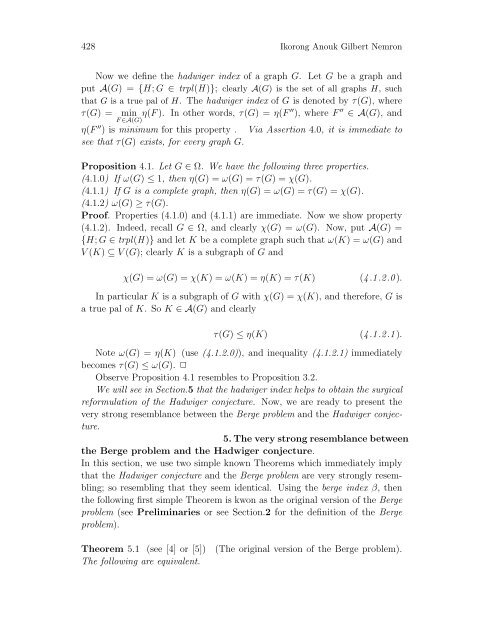With Concern the Difficult Part of the General Berge Last Theorem ...
With Concern the Difficult Part of the General Berge Last Theorem ...
With Concern the Difficult Part of the General Berge Last Theorem ...
Create successful ePaper yourself
Turn your PDF publications into a flip-book with our unique Google optimized e-Paper software.
428 Ikorong Anouk Gilbert Nemron<br />
Now we define <strong>the</strong> hadwiger index <strong>of</strong> a graph G. Let G be a graph and<br />
put A(G) ={H; G ∈ trpl(H )}; clearly A(G) is <strong>the</strong> set <strong>of</strong> all graphs H, such<br />
that G is a true pal <strong>of</strong> H. The hadwiger index <strong>of</strong> G is denoted by τ(G), where<br />
τ(G) = min η(F ). In o<strong>the</strong>r words, τ(G) =η(F ′′ ), where F ′′ ∈A(G), and<br />
F ∈A(G)<br />
η(F ′′ )isminimum for this property . Via Assertion 4.0, it is immediate to<br />
see that τ(G) exists, for every graph G.<br />
Proposition 4.1. Let G ∈ Ω. We have <strong>the</strong> following three properties.<br />
(4.1.0) If ω(G) ≤ 1, <strong>the</strong>n η(G) =ω(G) =τ(G) =χ(G).<br />
(4.1.1) If G is a complete graph, <strong>the</strong>n η(G) =ω(G) =τ(G) =χ(G).<br />
(4.1.2) ω(G) ≥ τ(G).<br />
Pro<strong>of</strong>. Properties (4.1.0) and (4.1.1) are immediate. Now we show property<br />
(4.1.2). Indeed, recall G ∈ Ω, and clearly χ(G) =ω(G). Now, put A(G) =<br />
{H; G ∈ trpl(H )} and let K be a complete graph such that ω(K) =ω(G) and<br />
V (K) ⊆ V (G); clearly K is a subgraph <strong>of</strong> G and<br />
χ(G) =ω(G) =χ(K) =ω(K) =η(K) =τ(K) (4 .1 .2 .0 ).<br />
In particular K is a subgraph <strong>of</strong> G with χ(G) =χ(K), and <strong>the</strong>refore, G is<br />
a true pal <strong>of</strong> K. SoK ∈A(G) and clearly<br />
τ(G) ≤ η(K) (4 .1 .2 .1 ).<br />
Note ω(G) =η(K) (use (4.1.2.0)), and inequality (4.1.2.1) immediately<br />
becomes τ(G) ≤ ω(G). ✷<br />
Observe Proposition 4.1 resembles to Proposition 3.2.<br />
We will see in Section.5 that <strong>the</strong> hadwiger index helps to obtain <strong>the</strong> surgical<br />
reformulation <strong>of</strong> <strong>the</strong> Hadwiger conjecture. Now, we are ready to present <strong>the</strong><br />
very strong resemblance between <strong>the</strong> <strong>Berge</strong> problem and <strong>the</strong> Hadwiger conjecture.<br />
5. The very strong resemblance between<br />
<strong>the</strong> <strong>Berge</strong> problem and <strong>the</strong> Hadwiger conjecture.<br />
In this section, we use two simple known <strong>Theorem</strong>s which immediately imply<br />
that <strong>the</strong> Hadwiger conjecture and <strong>the</strong> <strong>Berge</strong> problem are very strongly resembling;<br />
so resembling that <strong>the</strong>y seem identical. Using <strong>the</strong> berge index β, <strong>the</strong>n<br />
<strong>the</strong> following first simple <strong>Theorem</strong> is kwon as <strong>the</strong> original version <strong>of</strong> <strong>the</strong> <strong>Berge</strong><br />
problem (see Preliminaries or see Section.2 for <strong>the</strong> definition <strong>of</strong> <strong>the</strong> <strong>Berge</strong><br />
problem).<br />
<strong>Theorem</strong> 5.1 (see [4] or [5])<br />
The following are equivalent.<br />
(The original version <strong>of</strong> <strong>the</strong> <strong>Berge</strong> problem).
















